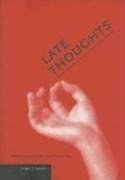

Intrigued and inspired by the neon beer signs on shopfronts in his San Francisco neighborhood, Bruce Nauman created his first neon piece, "Window or Wall Sign," in 1967. He wanted, he said, to achieve "an art that would kind of disappear--that was supposed to not quite look like art." Light offered Nauman a medium both elusive and effervescent, but one that could also aggressively convey a message. Over the first three decades of his career, Nauman used the medium of light to explore the twists and turns of perception, logic, and meaning with the earnest playfulness that characterizes all his art. "Elusive Signs" focuses on the discrete body of Nauman's work that uses neon and fluorescent light in signs and room installations, and includes images of nearly all Nauman's work with light. After "Window or Wall Sign," Nauman embarked on a series of neons that grappled with the semiotics of body and identity, and with "My Name as Though it Were Written on the Surface of the Moon" (1968), he forces the viewer to contemplate the role of naming in forming identity. Language--signs and symbols--plays an important role in Nauman's art. His later neon works emphasize the neon as a sign, presenting provocative twists of language and offering harsh and humorous sociopolitical commentary in such pieces as "Run from Fear, Fun from Rear" (1972). This series culminates in the monumental, billboard-size "One Hundred Live and Die" (1984), which employs overwhelming scale to bombard the viewer with sardonic aphorisms. In incisive essays that accompany the images of Nauman's work, Joseph Ketner II of the Milwaukee Art Museum (which originated the exhibit this book accompanies) and critics Janet Kraynak and Gregory Volk analyze the works in light both as a body of work and as an access point to Nauman's entire career. Distributed for the Milwaukee Art Museum.
具體描述
讀後感
評分
評分
評分
評分
用戶評價
相關圖書
本站所有內容均為互聯網搜索引擎提供的公開搜索信息,本站不存儲任何數據與內容,任何內容與數據均與本站無關,如有需要請聯繫相關搜索引擎包括但不限於百度,google,bing,sogou 等
© 2025 qciss.net All Rights Reserved. 小哈圖書下載中心 版权所有




















